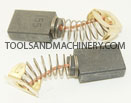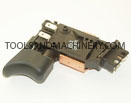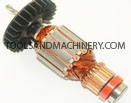Having a few problems with your power tools isn’t necessarily uncommon, it just comes along with the power-tooling territory. Among some of the more frequent complications experienced by craftsmen are the classic cases of “my tool shuts-off during use,” “my tool has trouble starting,” or even “my tool started fine yesterday, but won’t start at all today;” each of these cases, though, usually come together in one form or another, and often they are all symptoms of the same problem within your power tool. Fortunately though, with just a few steps, you can find out just which part in your power tool is causing all that fuss.
 With symptoms like these, it is very likely your carbon brushes or switch assembly causing all the hub-bub. Firstly, if your brushes have worn too low, if they have chipped, if burrs have formed, or if your brushes just can’t make or maintain contact with the armature, it will cause your tool to start and stop, to fuss during start-ups, or to not engage altogether. Because heavy wear, chips, and burrs (or binding formations around the brush’s carbon body) cause gaps in the electrical flow inside the tool, electrical flow can not complete its circuit and will either shut the tool off or prevent it from engaging.
With symptoms like these, it is very likely your carbon brushes or switch assembly causing all the hub-bub. Firstly, if your brushes have worn too low, if they have chipped, if burrs have formed, or if your brushes just can’t make or maintain contact with the armature, it will cause your tool to start and stop, to fuss during start-ups, or to not engage altogether. Because heavy wear, chips, and burrs (or binding formations around the brush’s carbon body) cause gaps in the electrical flow inside the tool, electrical flow can not complete its circuit and will either shut the tool off or prevent it from engaging.
 Similarly, although a bad switch is more likely to prevent the tool from doing anything at all, before it fails completely, it may also cause the above symptoms. The most visible mischief to a power switch is heat damage which will look like burning, charring, melting or discoloration of the switch assembly. The switch may have also suffered water damage or could have simply gone kaput with the rigors of wear and tear. If, of course, your brushes can not make contact with the armature, or if the switch has been damaged, they will both require a swift replacement. If, however, your brushes and switch appear healthy, move along to the tool’s armature.
Similarly, although a bad switch is more likely to prevent the tool from doing anything at all, before it fails completely, it may also cause the above symptoms. The most visible mischief to a power switch is heat damage which will look like burning, charring, melting or discoloration of the switch assembly. The switch may have also suffered water damage or could have simply gone kaput with the rigors of wear and tear. If, of course, your brushes can not make contact with the armature, or if the switch has been damaged, they will both require a swift replacement. If, however, your brushes and switch appear healthy, move along to the tool’s armature.
Hint: If shaking your power tool will usually bring a bit of life back into it, it is likely your brushes are causing the problem. Conversely, if shaking does you no good, it is more likely to be your switch.
 Because a damaged commutator can cause chipping or premature wearing in your brushes, if your brushes are very badly worn or damaged, you may choose to momentarily bypass checking the switch and move directly to the armature’s commutator bars. The commutator bars make contact with the carbon brushes to continue the electrical power flow in your tools and should form a perfect and perfectly smooth circle around the armature. If any bars are missing, smashed, elevated, or if there are any other signs of warping, this will cause gaps in the tool’s electrical flow and consequently, a poor and frustrating tool performance as well. Damage to the armature usually occurs during intense misuse or abuse of the tool and will spread to other components if not replaced rapidly.
Because a damaged commutator can cause chipping or premature wearing in your brushes, if your brushes are very badly worn or damaged, you may choose to momentarily bypass checking the switch and move directly to the armature’s commutator bars. The commutator bars make contact with the carbon brushes to continue the electrical power flow in your tools and should form a perfect and perfectly smooth circle around the armature. If any bars are missing, smashed, elevated, or if there are any other signs of warping, this will cause gaps in the tool’s electrical flow and consequently, a poor and frustrating tool performance as well. Damage to the armature usually occurs during intense misuse or abuse of the tool and will spread to other components if not replaced rapidly.
Hint: For the best performances, you must ensure all your bases are covered. If you can, it’s smart to check all three components when diagnosing start and stop behavior even if you find your problem early.
In the end, with start-stop action, or troubled start-ups, the most likely causes are your brushes, switch, or armature. Once you locate the problem though, this is generally a quick and easy fix. If you still experience problems after diagnosing and repairing your power tool, take it to an authorized power tool service center for a more thorough diagnosis.













